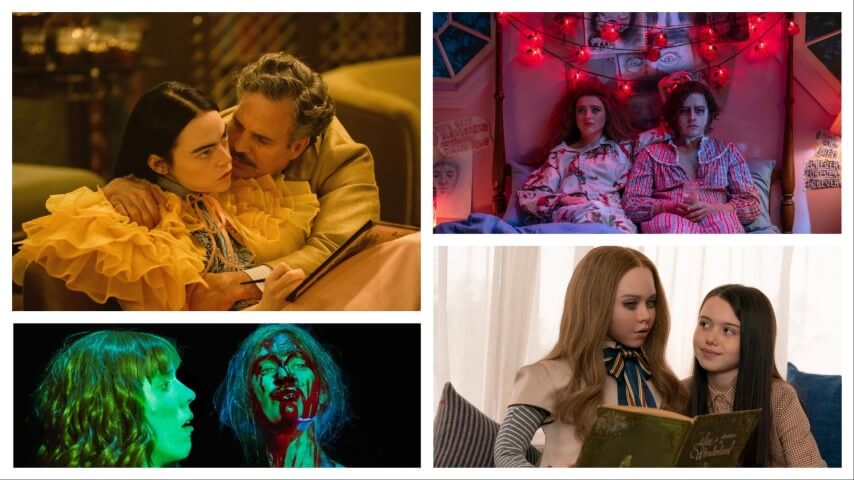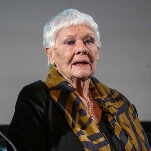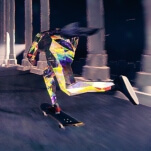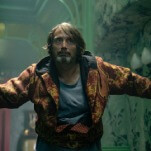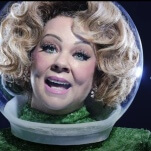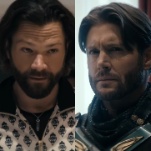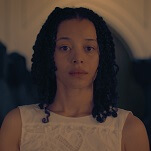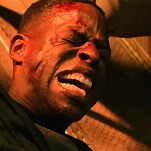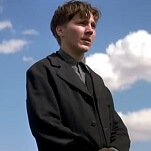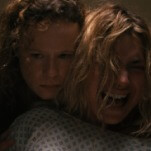In 1935’s Bride Of Frankenstein, the Monster (Boris Karloff) escapes a dungeon and flees to the modest hut of a blind hermit (O.P. Heggie). Beckoned by the hopeful tones of the hermit’s fiddle squeaking out “Ave Maria,” the Monster finds more than refuge. He finds a friend. “Alone, bad,” the Monster grunts. “Friend, good.” The scene encapsulates much of what makes Frankenstein both timeless and timely. Over the last five years, we’ve seen a rise in Frankenstein movies centered on companionship for a culture that’s more isolated than ever. These themes have never been far from Mary Shelley’s 1818 novel; the author herself faced incredible grief throughout her life as those close to her died suddenly and tragically. But the idea of Dr. Frankenstein foolishly playing god has taken a backseat to movies where the Creature serves as a companion, for good and ill. A rush of Frankenstein-inspired tales like Poor Things and Dead Lover arrives as society deals with an ongoing crisis of loneliness made worse (and reflected) by AI monsters terrorizing the digital countryside. Now Silicon Valley’s encouraging everyone to play god, and our monster movies are about how building a friend is no cure for being alone.
In May 2023, Surgeon General Vivek Murthy released an HHS advisory diagnosing American society with an epidemic of loneliness and isolation. Surveys found that “approximately half of U.S. adults were experiencing loneliness, with some of the highest rates among young adults.” The mad scientists of Silicon Valley have an idea to solve this. Tech has gone all-in on AI chatbots as the next big thing, unleashing cyber companions upon an increasingly lonesome consumer base. These algorithmic monsters aren’t throwing little girls in rivers or killing their creators’ brides, but they are driving teens to suicide, tearing marriages apart, and instigating AI psychosis. People are replacing friends, lovers, and therapists with software, and AI’s sycophantic responses are inviting the same God complexes explored in Shelley’s book. The tech world is reanimating other people’s work—and sometimes ghoulishly “resurrecting” murder victims—in the service of artificial life that offers something resembling companionship. It’s all a little on the nose, but while the consequences of using a digital creature as a cure for companionship have crept into reality, it’s been a fixture of multiplexes and streamers for the last few years.
Tech companies might want us to think their chatbots are as good as the real thing, but thus far, they’ve looked like they’re going in the direction of the Frankenstein-adjacent M3GAN, about a murderous AI doll brought to “life” by a scientist (Allison Williams) to entertain her lonely niece (Violet McGraw). M3GAN‘s yassified Shelley story is just high-tech proof that a fake friend is no substitute for the real thing. And yet, it seems like companies like the AI startup Friend, which makes a $129 wearable that supposedly talks to you and listens to your complaints, is taking the M3GAN route. Its annoying subway ads define “Friend” as “someone who listens, responds, and supports you.” One person tagged it, “And is a living being. Don’t use AI to cure your loneliness!! Reach out into the world!” Mary Shelley could’ve told you that, and yet, after 200 years, our cinema is still filled with characters certain that they know better.
If zombies were the monsters of the 2000s and vampires the 2010s, then build-a-buddy variations of Frankenstein’s Creature are the current monster du jour. It’s present at all budget levels, from Oscar winners to microbudget breakouts, and all degrees of faithfulness to source material where loneliness is ever-present. Shelley’s novel frames Dr. Frankenstein’s story in a series of letters from Robert Walton, an ambitious explorer heading to the most isolated location on Earth: The North Pole. Walton is a Frankenstein-esque character, too, someone in search of immortality through knowledge, but is irreparably alone. “I have no friend, Margaret,” he writes. “When I am glowing with the enthusiasm of success, there will be none to participate in my joy; I am assailed by disappointment, no one will sustain me in dejection.” He finds no solace in Frankenstein. After creating his Creature, he abandons it. In retaliation, the Creature kills everyone in Victor’s life. The Monster inflicts the loneliness he’s felt since birth upon his creator.
Newer movies imagine what would happen if the creator didn’t abandon the creature, and instead imagine the Monster as a cure for our isolation. Guillermo del Toro showcased his characteristic sympathy for the monster this month with his direct Frankenstein adaptation for Netflix, while next year, Maggie Gyllenhaal will take a more revisionary approach in which neither the Monster nor his Bride belongs dead. The Bride imagines what would happen if she survived the initial story, allowing her and the Monster to enjoy their relationship instead of dying moments after the switch was flipped. But even the looser Frankenstein films of recent years, movies like M3GAN and Lisa Frankenstein, satirize our solitude by exploring what happens when we create companionship instead of finding it in other people.
In Lisa Frankenstein, writer Diablo Cody reconfigures Frankenstein as teen-angst wish fulfillment. The Zelda Williams-directed horror-comedy tracks the grief of an alienated teen, Lisa (Kathryn Newton) in the wake of her mother’s violent murder. Lisa shuts down, vulnerable and alone. That’s where her monster comes in. No longer created by science, Lisa’s Creature (Cole Sprouse) arrives via a wish and a lightning bolt and becomes her weapon against a wicked stepmother (Carla Gugino) and the date-raping classmate (Bryce Romero) who wronged her. However, while her monster-enabled revenge restores Lisa’s confidence, it corrupts her, as she realizes she inflicted her own maternal loss on her likably dense stepsister Taffy (Liza Soberano). Like those using ChatGPT as a therapist, Lisa learns that artificial friendships can adversely affect one’s well-being and cloud one’s perception of the world.
Though Dead Lover pulls more directly from Shelley, it also expresses the inherent disappointment that comes from addressing loneliness and grief through resurrection. Co-writer and director Grace Glowicki stars as a stinky gravedigger who spends the early parts of the movie looking for love at funerals. Like many of the other characters discussed here, she’s hopelessly alone. Unlike many of these other characters, it’s because no one can bear to smell her. After she finally finds romance with a poet named Lover (Ben Petrie), he sets off on a quest to cure his low T and dies at sea. Heartbroken, Gravedigger resurrects the only part left of him: his finger. This proves inadequate, so she digs up the body of Lover’s sister (Leah Doz) to fill out the rest. This, of course, proves disastrous, requiring moral compromises that doom the protagonist. It’s a surreal comedy, using the Frankenstein story to toy with gender norms, queer romance, and the lengths some will go to avoid being alone. Like Lisa Frankenstein, Dead Lover treats its monster-movie trappings as a joke, but it’s built upon a real feeling—the feeling that romance would be a lot easier if we could just create our perfect partner.
In some cases, particularly when the Monster is the hero, it can find its own sense of community. In Poor Things, Yorgos Lanthimos adapts Alasdair Gray’s 1992 novel as a coming-of-age story that offers both doctor and creation monstrous attributes and human characteristics. The movie gives many of the Monster’s typical signifiers to Dr. Godwin Baxter (Willem Dafoe), a detached scientist who buries his loneliness in scientific pursuits. He can sympathize with his creation, Bella (Emma Stone), because, as a child, his late father treated him like a human guinea pig. Godwin certainly looks more traditionally monstrous than Bella, sporting a surgically deformed body that blows bubbles to digest. As his clinical urges evolve into paternal feelings, Bella gains agency, leaving the home and participating in a raucous sexual awakening, fending off would-be suitors and captors along the way. While Godwin copes with being an empty nester, Bella discovers her autonomy. It’s Frankenstein, except the Monster and Doctor have no hard feelings. Despite being a reanimated corpse with the brain of an infant, Bella solves her personal loneliness crisis by—get this—making some like-minded friends.
It’s fitting that Poor Things, the movie in which the Monster actually receives the love and trust of its creator, ends on a hopeful note (and found plenty of mainstream success). It recognizes that Frankenstein is not simply a warning against playing God, but against self-imposed isolation. Poor Things heightens that idea, not by chastising Godwin for attempting to deliver Prometheus’ fire to the people, but by allowing Bella to see her suitors as they really are. Sure, maybe everyone would be nicer to Frankenstein’s Monster if it looked like Emma Stone instead of a mutilated Willem Dafoe, but the film is more focused on punishing those who attempt to subjugate Bella to combat their alienation and rewarding those treating her with humanity. When the Monster is accepted and allowed to create community, rather than simply being a single person’s plaything, it finds what it has always been searching for: a friend.
